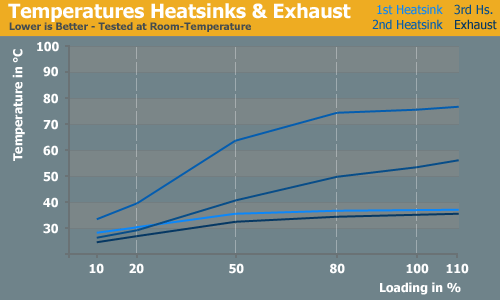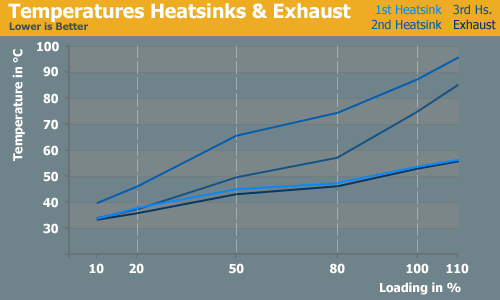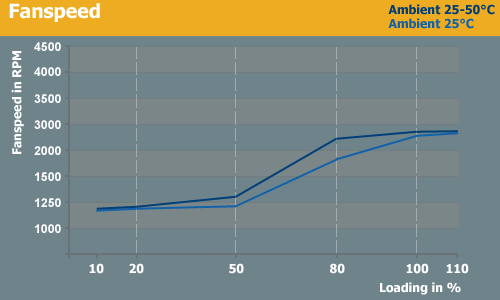400-450W PSU Roundup
by Christoph Katzer on November 6, 2007 4:00 AM EST- Posted in
- Cases/Cooling/PSUs
Antec PFC, Temperature, Fan Speed, and Acoustics


The heatsinks get far hotter than we have seen from similar models. The best comparison is the relation between the heatsink temperature and the exhaust temperature. The fan seems to be removing very little heat, since the temperature stays at an average level of 35°C at room temperature and 45°C in the heat chamber. The heatsink temperature is up to twice as hot at the exhausted temperature, clearly indicating the flaws with thermal management.


The installed 80mm fan wasn't the best idea, as we can clearly see from the temperature and fan speed results. A fan running at almost 3000 RPM should be enough to cool a moderate power supply like the 430W Earthwatts. The heatsinks simply are not getting enough cooling, and it all goes back to the overall design. The design of the heatsinks works best with a 120mm fan blowing directly at them. Antec chose to use an 80mm fan that moves air through the power supply in a very different fashion. The heatsinks do not get enough airflow, which means they can't dissipate heat, and they end up getting hot. It might be possible to design an effective cooling arrangement using an 80mm exhaust fan, but that would definitely require different heatsinks. Not surprisingly, the fan isn't particularly quiet either, especially in light of the low power output. We've seen much noisier PSUs, but those are often providing two or even three times as much power. At loads of around 430W, many PSUs are significantly quieter.



The heatsinks get far hotter than we have seen from similar models. The best comparison is the relation between the heatsink temperature and the exhaust temperature. The fan seems to be removing very little heat, since the temperature stays at an average level of 35°C at room temperature and 45°C in the heat chamber. The heatsink temperature is up to twice as hot at the exhausted temperature, clearly indicating the flaws with thermal management.


The installed 80mm fan wasn't the best idea, as we can clearly see from the temperature and fan speed results. A fan running at almost 3000 RPM should be enough to cool a moderate power supply like the 430W Earthwatts. The heatsinks simply are not getting enough cooling, and it all goes back to the overall design. The design of the heatsinks works best with a 120mm fan blowing directly at them. Antec chose to use an 80mm fan that moves air through the power supply in a very different fashion. The heatsinks do not get enough airflow, which means they can't dissipate heat, and they end up getting hot. It might be possible to design an effective cooling arrangement using an 80mm exhaust fan, but that would definitely require different heatsinks. Not surprisingly, the fan isn't particularly quiet either, especially in light of the low power output. We've seen much noisier PSUs, but those are often providing two or even three times as much power. At loads of around 430W, many PSUs are significantly quieter.











37 Comments
View All Comments
Christoph Katzer - Tuesday, November 6, 2007 - link
Yep, otherwise it's just getting too long and I thought actually nobody is too interested in that analyses anyway. Let me work something out for the next ones...Ripple is also coming today, I updated the 1200-1300 roundup already.
Super Nade - Tuesday, November 6, 2007 - link
Good to know! I understand that it is going to take a considerable amount of work at the outset, to do a bit of design analysis, but once you have the popular topologies employed figured out it should be a lot less work.The length of the review is unimportant if it makes an interesting read. (Hypothetical example) Having 10 pages on the fans employed is going to be be boring. Since you have a wide audience with varying degree of technical appetite, the length of the review should not matter if the content is arranged appropriately.
Best wishes,
S-N
floffe - Tuesday, November 6, 2007 - link
When referring to the 8800GT article, it'd be nice to point out that those 327W from the wall was with SLI. A single card didn't get much over 200W, so even the Ultra should be able to run that, however horrible it otherwise is a a PSU.As for the market, I just wish someone would produce a high quality 300W modular PSU. That'd be plenty for my needs.
xsilver - Tuesday, November 6, 2007 - link
Would you be ok if they charged you the same as a 400w PSU? because for the manufacturers, they're not going to the trouble of making another PSU that costs them almost exactly the same to make.(its like asking for a car with only 15hp because thats all u need ;)
jonnyGURU - Tuesday, November 6, 2007 - link
Exactly. The cost difference at that level is rarely more than a $1. So if it costs me $30 to build a 400W, and $29 to build a 350W, etc. why would I bother?Souka - Wednesday, November 7, 2007 - link
maybe because some people "think" a 350w power supply consumes 50w less than a 400w power supply...:)
Hinkdog - Tuesday, July 21, 2020 - link
My 430 watt Antec Earthwatts that I bought in 2008 just failed. 12 years, pretty cool. Guess the 80mm fan didn't hurt its longevity. I know no one is going to read this in 2020 but wanted to post it anyway.